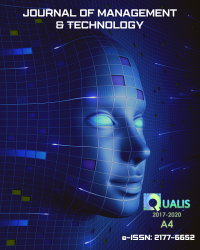Modeling regional economic growth in the context of simulation modeling of scientific and technological progress: case of the republic of tatarstan
DOI:
https://doi.org/10.20397/2177-6652/2023.v23i4.2716Palavras-chave:
Scientific and Technological Potential, Economic Growth, Fourth Industrial Revolution, Republic of Tatarstan, Production Function, Sustainability of Economic DevelopmentResumo
The article examines the role of scientific and technological progress in stimulating the economic growth of the Republic of Tatarstan. The basic factors of economic dynamics included in the neoclassical production function are labor, fixed capital, and scientific and technological progress. When including the production functions of scientific and technological progress in models, it is often understood as the potential for the creation and diffusion of innovations in the economic environment. In this article, scientific and technological progress is regarded as a set of human, financial, infrastructural, and institutional resources that determine the overall innovative capabilities of the region and the level of its effectiveness in the field of science and technology to ensure qualitative and structural parameters of economic growth and development, increasing competitiveness at the meso, macro, and global level. The authors’ approach includes a thorough examination of the scientific and technological potential of Tatarstan over the past decade, offering insights into its different aspects. The methodological framework is based on a combination of quantitative and econometric methods. Based on this approach to definition and the methodological tools for measuring scientific and technological progress proposed by the authors, the authors attempt to construct the Solow production function. The assessment results are employed to determine the specific parameters of how productive factors impact the dynamics of GRP (illustrated by Tatarstan) and to identify patterns that highlight the significance of scientific and technological progress in shaping the prospects of economic dynamics during the Fourth Industrial Revolution.
Referências
Balatskii, E. V. (2019). Globalnye Vyzovy Chetvertoi Promyshlennoi Revolyutsii [Global Challenges of the Fourth Industrial Revolution]. Terra Economicus, 17(2), 6-22.
Bourguignon, F. (2003). The Growth Elasticity of Poverty Reduction. Explaining Heterogeneity across Countries and Time Periods. In T. Eicher & S. Tyrnovsky (Eds.), Inequality and Growth: Theory and Policy Implications, Cambridge, MA: MIT Press.
Ekins, P. (2000). Economic Growth and Environmental Sustainability: The Prospects for Green Growth. London: Routledge.
Kondratev, N. D. (2002). Bolshie Tsikly Konyunktury i Teoriya Predvideniya [Large Cycles of Conjuncture and the Theory of Foresight]. Selected works. Moscow: Ekonomika.
Perez, C. (2011). Tekhnologicheskie Revolyutsii i Finansovyi Kapital: Dinamika Puzyrei i Periodov Protsvetaniya [Technological Revolutions and Financial Capital. The Dynamics of Bubbles and Periods of Prosperity]. Translated from English. Moscow: DELO.
Safiullin, M. R., & Elshin, L. A. (2023). Sanktsionnoe Davlenie na Ekonomiku Rossii: Puti Preodoleniya Izderzhek i Vygody Konfrontatsii v Ramkakh Importozameshcheniya [Sanctions Pressure on the Russian Economy: Ways to Overcome the Costs and Benefits of Confrontation within the Framework of Import Substitution]. Finansy: Teoriya i Praktika, 27(1), 150-161. https://doi.org/10.26794/2587-5671-2023-27-1-150-161.
Schumpeter, J. (1983). Teoriya Ekonomicheskogo Razvitiya [The Theory of Economic Development]. Moscow: Progress.
Teixeira, A. C., & Fortuna, N. (2010). Human Capital, R&D, Trade, and Long-Run Productivity. Testing the Technological Absorption Hypothesis for the Portuguese Economy, 1960-2001. Research Policy, 39(3), 335-350.
Vyas, V., & Vyas, R. (2019). Human Capital, its Constituents and Entrepreneurial Innovation: A Multilevel Modelling of Global Entrepreneurship Monitor Data. Technology Innovation Management Review, 9, 5-17.
Downloads
Publicado
Como Citar
Edição
Seção
Licença
Copyright (c) 2023 Revista Gestão & Tecnologia

Este trabalho está licenciado sob uma licença Creative Commons Attribution-NonCommercial 4.0 International License.
Os direitos, inclusive os de tradução, são reservados. É permitido citar parte de artigos sem autorização prévia desde que seja identificada a fonte. A reprodução total de artigos é proibida. Em caso de dúvidas, consulte o Editor.


